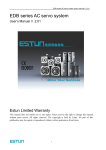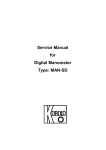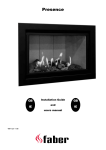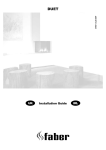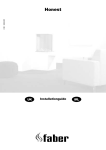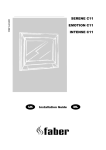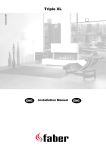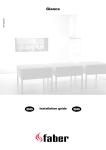Download Torch Installation instructions and User's manual
Transcript
Torch Installation instructions and User’s manual 40010733 -0837 Eng List of Contents: 1 2 3 Introduction ......................................................................... 3 Safety Instructions for the fitter ................................................ 3 Installation requirements ........................................................ 4 3.1 Construction instructions ................................................... 4 3.2 Requirements flue system and outlets ................................... 5 4 Installation instructions........................................................... 6 4.1 Preparation before mounting .............................................. 6 4.2 Placing the hearth: .......................................................... 7 4.3 Placing the gas connection................................................. 7 5 Pre-delivery check ................................................................. 7 5.1 Check function remote control ............................................ 8 5.1.1 Switching on the pilot light by means of remote control............ 8 5.1.2 Regulating the flame height.............................................. 8 5.1.3 Replacing the batteries ................................................... 8 5.2 Check function manual operation......................................... 9 5.2.1 Regulating the flame height.............................................. 9 5.2.2 Putting the appliance on the pilot light ............................... 10 5.2.3 Extinguishing the pilot light ............................................. 10 5.2.4 Table with error codes ................................................... 10 5.3 Function check of flue system ............................................ 11 5.4 Checking the pre-pressure ................................................ 11 5.4.1 Gauging pre-pressure:.................................................... 11 6 Final check and instruction customer ........................................12 7 Service...............................................................................12 7.1 Ordinary service checks ................................................... 12 7.1.1 Cleaning the glass......................................................... 12 7.1.2 Cleaning the combustion chamber ..................................... 13 7.1.3 Dismantling the burner................................................... 13 7.1.4 Dismantling the pilot light burner...................................... 13 8 Technical data .....................................................................13 9 User’s safety instructions .......................................................15 10 Operating instructions ...........................................................16 10.1 Operation by means of remote control ................................. 16 10.1.1 Switching on the pilot light by means of remote control........... 16 10.1.2 Regulating the flame height............................................. 16 10.1.3 Putting the appliance on the pilot light ............................... 16 10.1.4 Extinguishing the pilot light ............................................. 16 10.1.5 Replacing the batteries .................................................. 17 10.2 Operating the service panel on the hearth ............................. 17 10.2.1 Switching on the pilot light on the appliance ........................ 17 10.2.2 Regulating the flame height............................................. 18 10.2.3 Putting the appliance on the pilot light ............................... 18 10.2.4 Extinguishing the pilot light ............................................. 18 10.2.5 Error codes ................................................................. 18 11 Cleaning and maintenance ......................................................19 11.1 Cleaning the glass .......................................................... 19 12 Disposal of wrappings and appliance ............................................19 >>>>2 Eng 1 Introduction With this hearth you receive an installation and operation manual. Please read this manual and keep it safe for future use. Design: • Especially patented “Torch” flame by means of Faber International spot burner with torch effect. • The gas control valve is automatically operated. • Closed appliance; ventilation and exhaust by means of outer wall feed-through. • Remote control unit standard on all appliances. • CE approved. 2 Safety Instructions for the fitter • The appliance has been adjusted and sealed in the factory, in accordance with the category and pressure indicated on the registration plate. Check whether the data on the registration plate are in agreement with the local type of domestic gas and pressure. The fitter is not permitted to change these adjustments. • The appliance should be placed, connected and checked by a CORGI registered gas fitter, in accordance with national and local Gas Safety (Installation and Use) Regulations and installation instructions. • In the Netherlands the installation has to meet the requirements as laid down in the Building Code. The location and manner of outlet must satisfy the standards NPR 337860 (environmental pollution an dilution of smoke emission) and NPR 3378-61 (for the proper function). • In Belgium the appliance has to meet the requirements of the Belgian installation standard NBN D51-003. • The construction of the hearth should not be altered. >>>>3 Eng 3 Installation requirements 3.1 Construction instructions When building the chimney breast, take the following into account: • The chimney breast should be constructed of non-inflammable materials. • For detailed inner measurements see figure 1 and table 1. • We recommend you install the hearth first and then build up the chimney breast. • Always ventilate the space above the hearth. Install ventilation appliances with sufficient surface. These are available from Faber. • As is true for any heating appliance, the wallpaper, vinyl and other heat sensitive furnishings or paint close to the appliance could suffer discolouration. That is why you should use a special heat-resistant finishing coat. • To prevent cracks, you should adhere to a drying period of roughly 1 day per mm thickness when applying a new coating of stucco. • Make sure that the gas control tap near the hearth is easily accessible and operable at all times. • The lintel should not be placed directly on the hearth. If possible use a concrete lintel. Note: because a hearth is a source of heat, air circulation will arise. By natural air circulation moisture and volatile components from paint, building materials, floor coverings etc. that haven’t set yet, are sucked up. These components can be deposited on cold surfaces as soot. That is why we recommend you do not use the fire shortly after a renovation. Table 1 Inner size recess in mm Torch chimney breast A Width inner size 300 B Height inner size 842 C Depth inner size (minimum) 165 *For the points A to C the following applies: inner size=recess in the wall, tolerance of -0 mm and +5 mm. >>>>4 Eng Fig. 1: size specifications Torch 3.2 Requirements flue system and outlets The appliance is type C11. The combined in- and outlet can only be located through the facade. The length of the flue pipe can be defined by adding 50 mm to the thickness of the wall. The maximum length of the flue pipe is 600 mm and the maximum wall thickness therefore is 550 mm. Check whether the outlet desired by you satisfies the local installation requirements concerning pollution, proper functioning and dilution of smoke emission (see also “safety instructions for the gas fitter”, chapter 2). Some important requirements for proper functioning are: The façade outlet should be at least 0,5 m away from: • corners of the building • roof overhangs • balconies and such >>>>5 Eng 4 Installation instructions Follow the instructions in the order given for the best result: • Preparation before mounting • Placing the hearth • Placing the in- and outlets of the flue system • Placing the gas connection. Note! If possible place the hearth and the in- and outlets of the flue system before building up the chimney breast. 4.1 Preparation before mounting Before you place the hearth in its definite position, it would be sensible to remove the frame before it is placed. This will lower the risk of damages: 1. Draw the drill holes according to the picture (see fig.4.1) 2. Drill the holes 3. Remove the frame from the hearth 4. Dismount the wall bracket of the hearth Fig.4.1 5. Mount the wall bracket onto the wall with the help of a spirit level and with the screws and plugs supplied with this product (see fig. 4.2) 6. Measure the thickness of the wall 7. Saw the combined in- and outlet flue pipe to the correct length. The length of the outer pipe is the thickness of the wall plus 50mm. The inner pipe should stick out of the outer pipe for 20 mm. 8. The hearth can be placed now. >>>>6 Eng 4.2 Placing the hearth: • Place the hearth on the wall bracket • Mount the corner supports to the top and make sure the hearth is absolutely level • Construct the gas connection according to the requirements (see also §???) • Check the pipes for gas density. If mounted in the manner described above, the burner can always be dismounted for service purposes. • Mount the in- and outlet flue system onto the hearth • Fig.4.2 Mount the frame to the hearth. If possible, use magnets so that the frame fits closely to the wall. Note: after installation briefly burn the fire (for max. 1 hour) Next check for possible deposit/ white film on the glass. Remove this deposit. 4.3 Placing the gas connection Gas connection Make sure of a gas connection of ± Ø15mm directly from the gas meter, with near the appliance a (CE approved) gas control tap G 1/2" that should always be accessible. The connection to the hearth is made according to ISO 7-1 by means of a 3/8” conic female thread. Always check for gas density! 5 Pre-delivery check To make sure of proper functioning after constructing the hearth, the following points need to be checked: • remote control unit • manual control panel • pilot light • main burner • flue system • pre-pressure >>>>7 Eng 5.1 Check function remote control The hearth can be operated in two ways. In the unlikely event that the remote control unit should fail to work, the hearth can be operated by means of a manual control panel (see § 5.2). Every time a key on the remote control unit (see figure 5.1) is touched, there is an audible beep. If a series of beeps is heard, it means there is some kind of malfunction. In de malfunction table (see § 5.2.4) the malfunction can be identified. 5.1.1 1) Switching on the pilot light by means of remote control Press the keys with the star and the ball simultaneously for a minimum of 3 seconds. 2) The start-up procedure will be executed automatically 3) After the pilot light has been burning for a minimum of 10 seconds, the main burner on the hearth will be ignited 4) If the pilot light has not been burning for a minimum of 10 seconds, or if there is an electrical failure, the gas supply is automatically disconnected. 5.1.2 1) Regulating the flame height Fig.5.1 The flame height can be regulated by keeping the key with the little flame pressed down until the desired flame image has been achieved 2) If the same key is pressed briefly, the flame will go directly to the lowest position 3) By keeping the key with the big flame pressed down, the flame will increase in size until the highest position has been achieved 4) If the same key is pressed briefly, the flame will go directly to the highest position 5.1.3 Replacing the batteries In this set of controls only the remote control unit runs on batteries. These have a lifespan of approximately 1 year. Note: only use alkaline batteries. 1) Remove the lid at the back of the remote control unit 2) Remove the block battery from the niche. Make sure you don’t pull the wires. 3) Detach the battery from the connector 4) Replace it with a new alkaline long life battery 5) Replace the lid Note: Batteries are chemical waste and should be disposed of separately, according to local regulations. >>>>8 Eng 5.2 Check function manual operation If the appliance has been opened, the hearth can be operated by means of the manual control panel (see figure 5.2). Every time a touch control on the panel (see figure 5.2) is touched, there is an audible beep. If a series of beeps is heard, it means there is some kind of malfunction. In de malfunction table (see § 5.2.4) the malfunction can be identified. 1) Press the touch control with the star for a minimum of 3 seconds. 2) The start-up procedure will be executed automatically 3) After the pilot light has been burning for a minimum of 10 seconds, the main burner on the hearth will be ignited 4) If the pilot light has not been burning for a minimum of 10 seconds, or if there is an electrical failure, the gas Fig.5.2 supply is automatically disconnected. Possible causes of the extinction of the pilot light are: • Operating error • The security system kicking in, due to a malfunction in the in- and outlet flue system • Malfunction in the pilot light system • Air in the gas pipes 5.2.1 1) Regulating the flame height The flame height can be regulated by keeping the touch control with the little flame pressed down until the desired flame image has been achieved 2) If the same touch control is pressed briefly, the flame will go directly to the lowest position 3) By keeping the touch control with the big flame pressed down, the flame will increase in size until the highest position has been achieved 4) If the same touch control is pressed briefly, the flame will go directly to the highest position >>>>9 Eng 5.2.2 Putting the appliance on the pilot light If the hearth is not used for a brief period, there is a possibility of keeping it on the pilot light. Press the Stand by key for that function. 5.2.3 1) Extinguishing the pilot light If the hearth is in disuse for a considerable period, we recommend you extinguish the pilot light. You can do this by pressing the key with the ball . 2) Warning! If, by any cause, the pilot light is extinguished, wait for at least five minutes before attempting to reignite the pilot light. Get in touch with your gas fitter if the hearth regularly switches off. 5.2.4 Table with error codes If the processor notices an error, an alarm is given. See the table below for an explanation of these error codes. Alarm (Number of beeps) 3 Malfunction Operating Control panel malfunction Action to be taken Exchange the operating control panel and check whether the beeps have stopped Exchange the gas control valve. 4 Engine malfunction 5 Malfunction in the control circuit of the engine Repeat the start-up procedure and check whether the beeps have stopped Change the processor: the electronic control circuit has been damaged Repeat the start-up procedure and check whether the beeps have stopped > > > > 10 Eng 5.3 Function check of flue system 1. Let the hearth burn in the highest position. 2. Check the flame image. 3. After 10 minutes, check if the flame burns a clear yellow. Switch off the hearth in case the flame burns blue and check: a. The connections of the flue system (no leakage) b. The mounting of the outlet. The wall feed-through must be mounted with the right side up. c. Whether the appliance has the correct adjustments. Check the registration plate for type of gas and country of destination. 5.4 Checking the pre-pressure Because the pre-pressure in a domestic appliance is not always correct, it makes sense to check the pre-pressure during maintenance and repairs. 5.4.1 Gauging pre-pressure: 1. Turn off the gas control tap 2. Open the gas nipple a few turns (see Fig.5.3 figure 5.3) and connect a pressure gauge hose. 3. Check whether the pressure measured agrees with the pressure indicated on the registration plate 4. Take this gauge when the hearth is burning in the highest position and every other gas appliance is in use, and when the hearth is on the pilot light 5. If the pressure is too low, check whether the gas pipes are of sufficient diameter 6. If the pressure is too high (in excess of 5 mbar higher), you are not permitted to connect the appliance and you should get in touch with the local gas company Note: after checking the pre-pressure always close the gas nipple and check for tightness! > > > > 11 Eng 6 Final check and instruction customer • Give the customer instructions on how to operate the appliance manually and by remote control, including the replacement of the batteries • Give advice and instructions about maintenance and cleaning. Emphasize the danger of finger marks burning in on the glass surface and the glazed back wall. • Hand over these installation instructions and user’s manual • Recommend an annual service-check by a CORGI registered gas fitter. 7 Service To be able to guarantee the safety of this appliance, it is necessary that the appliance is given an annual service-check by a professional CORGI registered gas fitter. Important: Always close the gas connection tap before dismounting any part. After any repair or maintenance, always test the appliance for gas leakage, including the burners and the gas nipple. After installation, service and maintenance, the appliance and the outlet flue system should be checked for gas density and smoke density. 7.1 Ordinary service checks 1. Cleaning of (if necessary): a. the glass b. the combustion chamber c. the burner d. the pilot light 2. Perform a check as described in chapter 5 3. Perform a visual check of the smoke in- and outlet flue system and check for damages 7.1.1 Cleaning the glass Depending on the intensity of use, a deposit will be formed on the glass. You can clean the glass by removing the window (see figure 7.1). Most of the deposit can be removed by rubbing it with a dry cloth. If necessary you can use a ceramic cleaning agent. Note: prevent the making of finger marks on the glass. Fig.7.1 These cannot be removed once the fire has burnt them into the glass! > > > > 12 Eng 7.1.2 Cleaning the combustion chamber Before cleaning, allow the hearth to cool off first. You can clean the combustion chamber with a vacuum cleaner. If necessary, the glazed inner wall can be cleaned with a scourer and a little bit of washing up liquid. 7.1.3 Dismantling the burner 1. Disconnect the gas supply 2. Remove the glass (see figure 7.1) 3. Take the burner out of the combustion chamber. This can be cleaned now. 7.1.4 Dismantling the pilot light burner 1. Disconnect the gas supply 2. Remove the glass (see figure 7.1) 3. Take the burner out of the combustion chamber. This can be cleaned now. 8 Technical data Country Cat Type of appliance Adjusted to type of gas Nominal load Hi Pipe pressure Gas consumption at full nominal load (15º C/ 1013 mbar) NL I 2L C11 BE/FR I 2e+ C11 G25 G20 [kW] [mbar] 2,2 2,4 25 20 [l/h] [mm] 269 258 1,2 1,2 Type of pilot light Sit 145 Sit 145 Connection smoke outlet/air inlet 100-150 100-150 Gas injector diameter Manual Control panel ACS2 ACS2 Remote control unit RF EDB10 EDB10 9V adapter 9V adapter. Voltage receiver Voltage sender Gas connection V V ISO 7-1 9V block battery 9V blockbattery 3/8”female thread 3/8” female thread > > > > 13 Eng Operating Instructions > > > > 14 Eng 9 User’s safety instructions These instructions should be carefully read and adhered to: • The appliance has been designed for heating purposes. This means that all surfaces of the hearth, except the controls, but including the glass, can become very hot (>100 °C) • If you find or suspect a gas leak, turn off the gas main and get in touch with your gas fitter • Don’t use the hearth if the glass is broken • Get in touch with your gas fitter in case the hearth regularly switches off • The hearth has an alarm system that automatically turns off the gas main when there is too high an accumulation of smoke in the combustion chamber or when the gas supply has been temporarily disconnected. Wait for at least five minutes before you reignite the hearth • Don’t place any curtains, clothes, laundry, furniture or other inflammable materials in the neighbourhood of the appliance. The minimum safe distance is 100 cm • Because of the newness of the materials these can spread a certain smell the first few times the hearth is switched on • Switch off the hearth if you don’t use the appliance for an extended period • Don’t allow children to use the remote control unit without adult supervision • Note: Because the hearth is a source of heat, air circulation will arise. That is why it is important that you do not use the hearth shortly after a renovation. By natural air circulation moisture and volatile components from paint, building materials, floor coverings etc. that haven’t set yet, are sucked up. These components can be deposited on cold surfaces as soot. The first time you should use the hearth depends on various circumstances. Consult your gas fitter on this matter. > > > > 15 Eng 10 Operating instructions The Torch is intended to be operated by the remote control unit that is supplied with the appliance. Only for service purposes or if the batteries are empty, can the hearth be operated manually by means of a manual control panel.(see §10.2). 10.1 Operation by means of remote control Every time the remote control unit (see figure 10.1) is used, the appliance will give an audible beep. The receiver will also give a series of beeps if a malfunction is detected. See the malfunction table (§10.2.5) for the meaning of these series of beeps. 10.1.1 Switching on the pilot light by means of remote control 1) Press the keys with the star and the ball simultaneously for a minimum of 3 seconds. 2) The start-up procedure will be executed automatically 3) After the pilot light has been burning for a minimum of 10 seconds, the main burner on the hearth will be ignited and burn in the highest position. 4) If the pilot light has not kept on burning for 10 seconds, or if there an electrical failure is detected, the gas supply will automatically be disconnected. Fig.10.1 10.1.2 Regulating the flame height 1) The flame height can be regulated by keeping the key with the little flame pressed down until the desired flame image has been achieved 2) If the same key is pressed briefly, the flame will go directly to the lowest position 3) By keeping the key with the big flame pressed down, the flame will increase in size until the highest position has been achieved 4) If the same key is pressed briefly, the flame will go directly to the highest position. 10.1.3 Putting the appliance on the pilot light If the hearth is not used for a brief period, there is a possibility of keeping it on the pilot light. Press the Stand by key for that function. 10.1.4 Extinguishing the pilot light If the hearth is in disuse for a considerable period, we recommend you extinguish the pilot light. You can do this by pressing the key with the ball . > > > > 16 Eng 10.1.5 Replacing the batteries In this set of controls only the remote control unit runs on batteries. These have a lifespan of approximately 1 year. Note: only use alkaline batteries. 6) Remove the lid at the back of the remote control unit 7) Remove the block battery from the niche. Make sure you don’t pull the wires. 8) Detach the battery from the connector 9) Replace it with a new alkaline long life battery 10) Replace the lid Note: Batteries are chemical waste and should be disposed of separately, according to local regulations. 10.2 Operating the service panel on the hearth If the appliance has been opened (remove the frame) the hearth can be operated by means of the manual control panel (see figure 10.2). Every time a touch control is operated, there is an audible beep. if a series of beeps is heard, it means a malfunction has been detected. In the malfunction table (see §10.2.5) the malfunction can be identified. 10.2.1 Switching on the pilot light on the appliance 1) Press the touch control with the star for a minimum of 3 seconds. 2) The start-up procedure will be executed automatically 3) After the pilot light has been burning for about 10 seconds, the main burner on the hearth will be ignited and burn in the highest position. 4) If the pilot light has not kept on burning for 10 seconds, or if an electrical failure is Fig.10.2 detected, the gas supply will automatically be disconnected. Possible causes of the extinction of the pilot light are: • Operating error • The security system kicking in, due to a malfunction in the in- and outlet flue system • Malfunction in the pilot light system • Air in the gas pipes > > > > 17 Eng 10.2.2 Regulating the flame height 1) The flame height can be regulated by keeping the touch control with the little flame pressed down until the desired flame image has been achieved 2) If the same touch control is pressed briefly, the flame will go directly to the lowest position 3) By keeping the touch control with the big flame pressed down, the flame will increase in size until the highest position has been achieved 4) According to your wishes, the flame can be made smaller by pressing on the touch control with the little flame . 5) If the touch control with the big flame is pressed briefly, the flame will go directly to the highest position. 10.2.3 Putting the appliance on the pilot light If the hearth is not used for a brief period, there is a possibility of keeping it on the pilot light. Press the Stand by touch control for that function. 10.2.4 Extinguishing the pilot light 1) If the hearth is in disuse for a considerable period, we recommend you extinguish the pilot light. You can do this by pressing the key with the ball . 2) Warning! If, by any cause, the pilot light is extinguished, wait for at least five minutes before attempting to reignite the pilot light. Get in touch with your gas fitter if the hearth regularly switches off. 10.2.5 Error codes If the processor notices an error, an alarm is given. See the table below for an explanation of these error codes. Alarm (Number of beeps) Malfunction Action to be taken 3 Manual control panel malfunction Have the gas fitter install a new manual control panel 4 Engine malfunction Have the gas fitter install a new gas control valve 5 Malfunction in the control circuit of the engine Have the gas fitter install a new electronic control circuit > > > > 18 Eng 11 Cleaning and maintenance The appliance should be checked and cleaned annually by a CORGI registered gas fitter. The in- and outlet flue system should also be cleaned and checked. Before you clean the appliance, always switch it off first and allow time for the appliance to cool down. 11.1 Cleaning the glass 1) Remove the window from the hearth (see figure 7.1). 2) For cleaning the glass, see § 7.1.1 3) Most of the deposit can be removed by rubbing it with a dry cloth. If necessary you can use a ceramic cleaning agent. 4) Note: prevent the making of finger marks on the glass. These cannot be removed once the fire has burnt them into the glass! 12 Disposal of wrappings and appliance The wrapping materials of the appliance can be recycled. The following could be used: • Cardboard box • CFC-free polystyrene foam (soft) • Wood • Synthetic materials • Paper These materials, as well as the batteries in the remote control unit should be disposed of in a responsible fashion and in accordance with local government regulations. Batteries are chemical waste. Remove the batteries first before disposing of the remote control unit. The government can also provide you with information about the disposal of appliances in a responsible fashion. > > > > 19 Eng Saturnus 8 NL - 8448 CC Heerenveen P.O Box 219 NL - 8440 AE Heerenveen T. +31(0)513 656500 F. +31(0)513 656501 > > > > 20






















